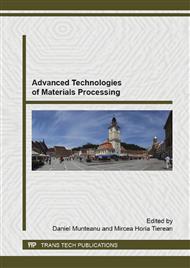p.64
p.72
p.80
p.88
p.98
p.105
p.115
p.123
p.127
Inoculation Enhancing Effects on Chill Tendency in the Mould Inoculated Grey Cast Iron
Abstract:
Inoculation is a treatment applied to the liquid base iron, to supply one or more elements, such as Al, Ba, Ca, Zr, Sr, Ce, La etc. with active roles in developing graphite nucleation sites. The efficiency of inoculants is directly dependent on the sulphur level: lower sulphur, lower inoculating power or unpredictable results. The objective of this paper is to examine the effects of a S and O containing inoculant enhancer [S,O,Al,Ca-FeSi alloy] to conventional Ca,Ba-FeSi alloy, in the mold treatment of electrically melted grey iron at 0.035%S, 0.002%Al, 0.0005%Zr, (%Mn) x (%S) < 0.02. The wedge test samples [W3 – ASTM A367] were used to evaluate the influence of the cooling rate and inoculation on the carbides formation. It was re-confirmed that for above mentioned critical chemistry conditions, this iron is sensitive to chill formation, despite the carbon equivalent level at 3.8%. Inoculation enhancement increased the effectiveness of the Ca,Ba-FeSi standard inoculant.
Info:
Periodical:
Pages:
98-104
Citation:
Online since:
October 2015
Authors:
Keywords:
Price:
Сopyright:
© 2015 Trans Tech Publications Ltd. All Rights Reserved
Share:
Citation:


